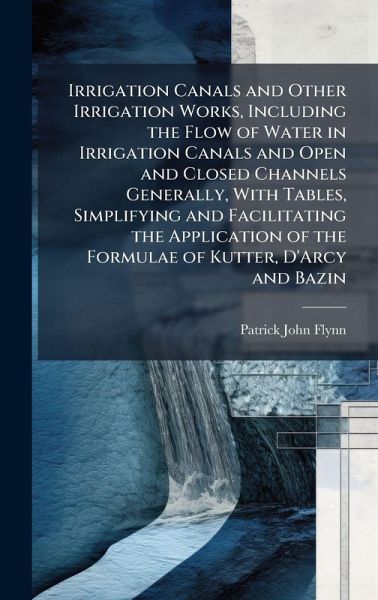
Irrigation Canals and Other Irrigation Works, Including the Flow of Water in Irrigation Canals and Open and Closed Channels Generally, With Tables, Simplifying and Facilitating the Application of the Formulae of Kutter, D'Arcy and Bazin
Versandkostenfrei!
Versandfertig in über 4 Wochen
41,99 €
inkl. MwSt.
Weitere Ausgaben:

PAYBACK Punkte
21 °P sammeln!
"Irrigation Canals and Other Irrigation Works" is a comprehensive treatise on the principles and practices of irrigation engineering, originally published in 1892. This detailed work by Patrick John Flynn delves into the intricacies of designing, constructing, and maintaining irrigation canals and related structures. It offers an exhaustive examination of water flow dynamics within both open and closed channels. The book provides essential tables and methodologies designed to simplify the application of complex hydraulic formulae developed by eminent scientists such as Kutter, D'Arcy, and Bazi...
"Irrigation Canals and Other Irrigation Works" is a comprehensive treatise on the principles and practices of irrigation engineering, originally published in 1892. This detailed work by Patrick John Flynn delves into the intricacies of designing, constructing, and maintaining irrigation canals and related structures. It offers an exhaustive examination of water flow dynamics within both open and closed channels. The book provides essential tables and methodologies designed to simplify the application of complex hydraulic formulae developed by eminent scientists such as Kutter, D'Arcy, and Bazin. This makes it an invaluable resource for engineers and practitioners involved in irrigation projects. Its enduring relevance lies in its thorough treatment of fundamental concepts, offering insights that remain pertinent to modern irrigation techniques and water management strategies. This work has been selected by scholars as being culturally important, and is part of the knowledge base of civilization as we know it. This work was reproduced from the original artifact, and remains as true to the original work as possible. Therefore, you will see the original copyright references, library stamps (as most of these works have been housed in our most important libraries around the world), and other notations in the work. This work is in the public domain in the United States of America, and possibly other nations. Within the United States, you may freely copy and distribute this work, as no entity (individual or corporate) has a copyright on the body of the work. As a reproduction of a historical artifact, this work may contain missing or blurred pages, poor pictures, errant marks, etc. Scholars believe, and we concur, that this work is important enough to be preserved, reproduced, and made generally available to the public. We appreciate your support of the preservation process, and thank you for being an important part of keeping this knowledge alive and relevant.


